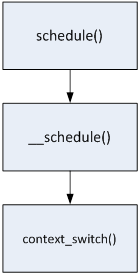7.switch_to到底干了啥?
第六讲(传送门:fork + execve:一个进程的诞生)我们介绍了进程的诞生,可是操作系统中有很多进程,进程之间怎么切换的,又有哪些奥秘?我们回到源码,细细阅读。
操作系统原理中介绍了大量进程调度算法,这些算法从实现的角度看仅仅是从运行队列中选择一个新进程,选择的过程中运用了不同的策略而已。
对于理解操作系统的工作机制,反而是进程的调度时机与进程的切换机制更为关键。
进程调度的时机:
1. 中断处理过程(包括时钟中断、I/O中断、系统调用和异常)中,直接调用schedule(),或者返回用户态时根据need_resched标记调用schedule();
2. 内核线程可以直接调用schedule()进行进程切换,也可以在中断处理过程中进行调度,也就是说内核线程作为一类的特殊的进程可以主动调度,也可以被动调度;
3. 用户态进程无法实现主动调度,仅能通过陷入内核态后的某个时机点进行调度,即在中断处理过程中进行调度。
进程的切换
为了控制进程的执行,内核必须有能力挂起正在CPU上执行的进程,并恢复以前挂起的某个进程的执行,这叫做进程切换、任务切换、上下文切换;
挂起正在CPU上执行的进程,与中断时保存现场是不同的,中断前后是在同一个进程上下文中,只是由用户态转向内核态执行;
进程上下文包含了进程执行需要的所有信息
1. 用户地址空间:包括程序代码,数据,用户堆栈等
2. 控制信息:进程描述符,内核堆栈等
3. 硬件上下文(注意中断也要保存硬件上下文只是保存的方法不同)
schedule()函数选择一个新的进程来运行,并调用context_switch进行上下文的切换,这个宏调用switch_to来进行关键上下文切换。
next= pick_next_task(rq, prev);//进程调度算法都封装这个函数内部
context_switch(rq,prev, next);//进程上下文切换
switch_to利用了prev和next两个参数:prev指向当前进程,next指向被调度的进程
我们从schedule()函数开始,一步步分析,看内核为切换进程做了哪些工作。schedule()函数位于linux-3.18.6\kernel\sched\core.c文件中。
asmlinkage__visible void __sched schedule(void)
{
struct task_struct *tsk = current;
sched_submit_work(tsk);
__schedule();
}__visible指出在内核的任何位置都可以调用schedule()。schedule()的尾部调用了__schedule(),我们进入__schedule()看看,__schedule()位于linux-3.18.6\kernel\sched\core.c文件中。
进入__schedule();之后的函数栈为:schedule()-> __schedule()。
static void__sched __schedule(void)
{
struct task_struct *prev, *next;
unsigned long *switch_count;
struct rq *rq;
int cpu;
need_resched:
preempt_disable();
cpu = smp_processor_id();
rq = cpu_rq(cpu);
rcu_note_context_switch(cpu);
prev = rq->curr;
schedule_debug(prev);
if (sched_feat(HRTICK))
hrtick_clear(rq);
/*
* Make sure thatsignal_pending_state()->signal_pending() below
* can't be reordered with__set_current_state(TASK_INTERRUPTIBLE)
* done by the caller to avoid the race withsignal_wake_up().
*/
smp_mb__before_spinlock();
raw_spin_lock_irq(&rq->lock);
switch_count = &prev->nivcsw;
if (prev->state && !(preempt_count()& PREEMPT_ACTIVE)) {
if(unlikely(signal_pending_state(prev->state, prev))) {
prev->state =TASK_RUNNING;
} else {
deactivate_task(rq,prev, DEQUEUE_SLEEP);
prev->on_rq = 0;
/*
* If a worker went to sleep, notify and askworkqueue
* whether it wants to wake up a task tomaintain
* concurrency.
*/
if (prev->flags& PF_WQ_WORKER) {
structtask_struct *to_wakeup;
to_wakeup =wq_worker_sleeping(prev, cpu);
if(to_wakeup)
try_to_wake_up_local(to_wakeup);
}
}
switch_count =&prev->nvcsw;
}
if (task_on_rq_queued(prev) ||rq->skip_clock_update < 0)
update_rq_clock(rq);
next = pick_next_task(rq, prev);
clear_tsk_need_resched(prev);
clear_preempt_need_resched();
rq->skip_clock_update = 0;
if (likely(prev != next)) {
rq->nr_switches++;
rq->curr = next;
++*switch_count;
context_switch(rq, prev,next); /* unlocks the rq */
/*
* The context switch have flipped the stackfrom under us
* and restored the local variables which weresaved when
* this task called schedule() in the past.prev == current
* is still correct, but it can be moved toanother cpu/rq.
*/
cpu = smp_processor_id();
rq = cpu_rq(cpu);
} else
raw_spin_unlock_irq(&rq->lock);
post_schedule(rq);
sched_preempt_enable_no_resched();
if (need_resched())
goto need_resched;
}__schedule(void)的关键代码是
next =pick_next_task(rq, prev)pick_next_task()封装了Linux的进程调度策略,我们不关注Linux使用了何种进程调度策略(有兴趣的童鞋可以深入研究pick_next_task()函数),总之Linux选出了下一个将要执行的进程。
next =pick_next_task(rq, prev)得到next之后下一步工作要完成进程上下文的切换,进程上下文的切换主要通过
context_switch(rq,prev, next);来实现。
我们进入context_switch(rq,prev, next);函数,看看进程上下文切换的具体过程。context_switch()位于linux-3.18.6\kernel\sched\core.c文件中。
注意,进入context_switch()之后的函数栈为:schedule()-> __schedule() –> context_switch()。
static inlinevoid
context_switch(structrq *rq, struct task_struct *prev,
struct task_struct *next)
{
struct mm_struct *mm, *oldmm;
prepare_task_switch(rq, prev, next);
mm = next->mm;
oldmm = prev->active_mm;
/*
* For paravirt, this is coupled with an exitin switch_to to
* combine the page table reload and the switchbackend into
* one hypercall.
*/
arch_start_context_switch(prev);
if (!mm) {
next->active_mm = oldmm;
atomic_inc(&oldmm->mm_count);
enter_lazy_tlb(oldmm, next);
} else
switch_mm(oldmm, mm, next);
if (!prev->mm) {
prev->active_mm = NULL;
rq->prev_mm = oldmm;
}
/*
* Since the runqueue lock will be released bythe next
* task (which is an invalid locking op but inthe case
* of the scheduler it's an obviousspecial-case), so we
* do an early lockdep release here:
*/
spin_release(&rq->lock.dep_map,1, _THIS_IP_);
context_tracking_task_switch(prev,next);
/* Here we just switch the registerstate and the stack. */
switch_to(prev, next, prev);
barrier();
/*
* this_rq must be evaluated again because prevmay have moved
* CPUs since it called schedule(), thus the'rq' on its stack
* frame will be invalid.
*/
finish_task_switch(this_rq(), prev);
}context_switch()中的关键代码为
switch_to(prev,next, prev);switch_to()是一个宏,而不是一个函数。我们注意到switch_to()头顶上的注释,/* Here we just switch the register state and the stack. */:切换寄存器的状态以及切换next进程和prev进程的堆栈。
我们去看看switch_to()的代码实现,switch_to()位于linux-3.18.6\arch\x86\include\asm\switch_to.h文件中。进入switch_to()后我们的函数栈为:schedule() -> __schedule() –> context_switch() –> switch_to()。(switch_to()虽然不算函数,可为了表示代码执行过程,姑且把switch_to()压入函数栈吧~)。
/*
* Saving eflags is important. It switches notonly IOPL between tasks,
* it also protects other tasks from NT leakingthrough sysenter etc.
*/
#defineswitch_to(prev, next, last) \
do { \
/* \
* Context-switching clobbers all registers, sowe clobber \
* them explicitly, via unused outputvariables. \
* (EAX and EBP is not listed because EBP issaved/restored \
* explicitly for wchan access and EAX is thereturn value of \
* __switch_to()) \
*/ \
unsigned long ebx, ecx, edx, esi, edi; \
\
asm volatile("pushfl\n\t" /* save flags */ \
"pushl %%ebp\n\t" /* save EBP */ \
"movl %%esp,%[prev_sp]\n\t" /* save ESP */ \
"movl %[next_sp],%%esp\n\t" /* restore ESP */ \
"movl $1f,%[prev_ip]\n\t" /* save EIP */ \
"pushl %[next_ip]\n\t" /* restore EIP */ \
__switch_canary \
"jmp __switch_to\n" /* regparm call */ \
"1:\t" \
"popl %%ebp\n\t" /* restore EBP */ \
"popfl\n" /* restore flags */ \
\
/* output parameters */ \
: [prev_sp] "=m"(prev->thread.sp), \
[prev_ip] "=m"(prev->thread.ip), \
"=a" (last), \
\
/* clobbered output registers: */ \
"=b" (ebx), "=c"(ecx), "=d" (edx), \
"=S" (esi), "=D"(edi) \
\
__switch_canary_oparam \
\
/* input parameters: */ \
: [next_sp] "m" (next->thread.sp), \
[next_ip] "m" (next->thread.ip), \
\
/* regparm parameters for __switch_to():*/ \
[prev] "a" (prev), \
[next] "d" (next) \
\
__switch_canary_iparam \
\
: /* reloaded segment registers */ \
"memory"); \
} while (0)switch_to()是AT&T语法的gcc内嵌汇编,其中已有不少注释,我来一句句的翻译注释吧。
1.
"pushfl\n\t"把当前进程(prev)的flag压入当前进程的内核堆栈;
2.
"pushl %%ebp\n\t"把当前进程(prev)的内核堆栈基址(%ebp寄存器值)压入当前进程的内核堆栈;
3.
"movl%%esp,%[prev_sp]\n\t"结合/* outputparameters */下的[prev_sp] "=m" (prev->thread.sp)可知%[prev_sp]代表prev->thread.sp。也就是把当前进程(prev)的内核堆栈栈顶(%esp寄存器值)保存到prev->thread.sp中。
4.
"movl%[next_sp],%%esp\n\t"结合/* inputparameters: */下的[next_sp] "m"(next->thread.sp)可知%[next_sp]代表next->thread.sp。也就是把next进程的内核堆栈栈顶(next->thread.sp值)还原到esp寄存器中。
5.
"movl%%esp,%[prev_sp]\n\t"
"movl %[next_sp],%%esp\n\t"这两步完成了内核堆栈的切换。
"movl %[next_sp],%%esp\n\t"这句之后的堆栈操作都是在next进程(next)的内核堆栈中进行的。
6.
"movl$1f,%[prev_ip]\n\t"把"1:\t"地址赋给prev进程的IP指针,当prev进程下次被switch_to回来时,就从"1:\t"这个位置开始执行,"1:\t"的后面两句是 "popl%%ebp\n\t"和"popfl\n",恢复prev进程的flag和内核堆栈基址。
7.
"pushl%[next_ip]\n\t"结合/* inputparameters: */下的[next_ip] "m"(next->thread.ip)可知%[next_ip]代表next->thread.ip。也就是把next进程的ip指针(执行起点)压入next进程的内核堆栈栈顶。
8.
"jmp __switch_to\n"__switch_to是一个函数,这里没有call __switch_to函数,而是jmp __switch_to,jmp的方式通过寄存器传递参数。请看/* regparm parameters for __switch_to(): */ \注释
[prev] "a"(prev),
[next] "d" (next)通过”a”(表示eax寄存器)和”d”(表示edx寄存器)传递参数。因为我们没有call __switch_to,故没有把__switch_to函数的下一条指令压入next进程的内核堆栈,虽然__switch_to没有被call,但是不影响__switch_to返回(ret)时pop(弹出)next进程内核堆栈栈顶的值,并把该值赋给了next的IP指针,next根据IP 指针指向的位置开始执行。
__switch_to返回时弹出的值是什么呢?next是要被换入执行的进程,那么next之前肯定被换出过,next被换出时同样执行了以下两句:
"movl $1f,%[prev_ip]\n\t"
"pushl %[next_ip]\n\t"这两句使next的内核堆栈栈顶保存了"1:\t"的位置。
所以__switch_to返回时弹出了"1:\t"的位置,并把该位置赋给next的IP指针,进而可知next的开始执行位置是"1:\t"。
9.
"popl %%ebp\n\t" /* restore EBP */ \
"popfl\n" /* restore flags */ \恢复next进程的内核堆栈和标志,接下来next进程就可以愉快的执行了!
__switch_to的模糊地带:
"movl%%esp,%[prev_sp]\n\t"
"movl%[next_sp],%%esp\n\t"这两句话把prev的内核堆栈切换为了next的内核堆栈。
但是到
"1:\t"时才开始执行next进程的第一条指令。
中间的这一段
"movl$1f,%[prev_ip]\n\t" /*save EIP */ \
"pushl%[next_ip]\n\t" /* restoreEIP */ \
__switch_canary \
"jmp__switch_to\n" /* regparmcall */ \使用的是next进程的内核堆栈,但是还算在prev进程里执行。
总的而言
"movl%%esp,%[prev_sp]\n\t"
"movl%[next_sp],%%esp\n\t"
"movl$1f,%[prev_ip]\n\t" /*save EIP */ \
"pushl%[next_ip]\n\t" /* restoreEIP */ \
__switch_canary \
"jmp__switch_to\n" /* regparm call */ \
"1:\t"这段是prev和next相对模糊的地方,说不清是属于哪个进程的执行序列。


